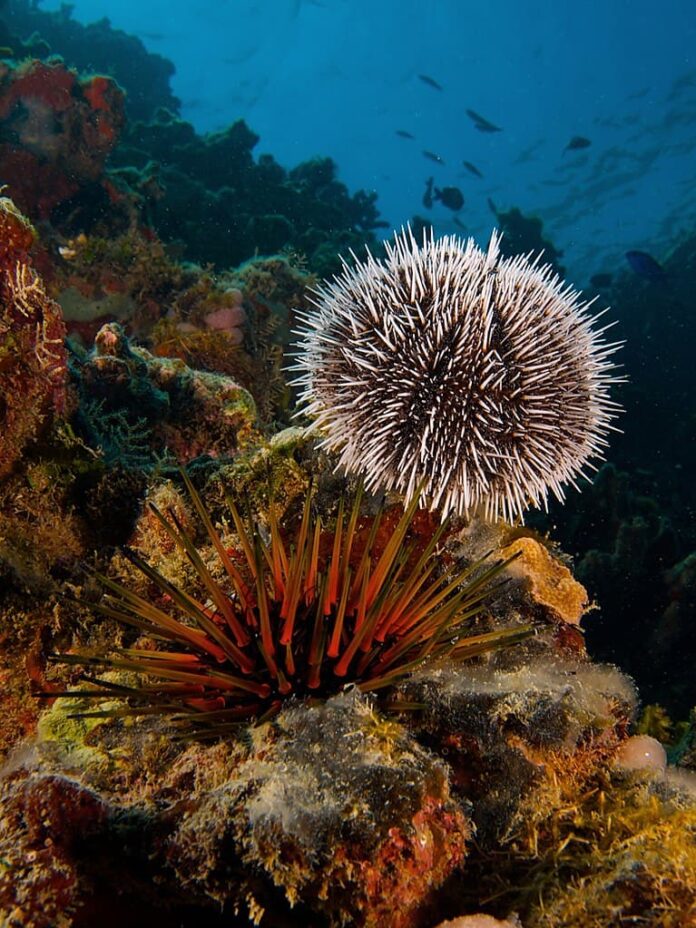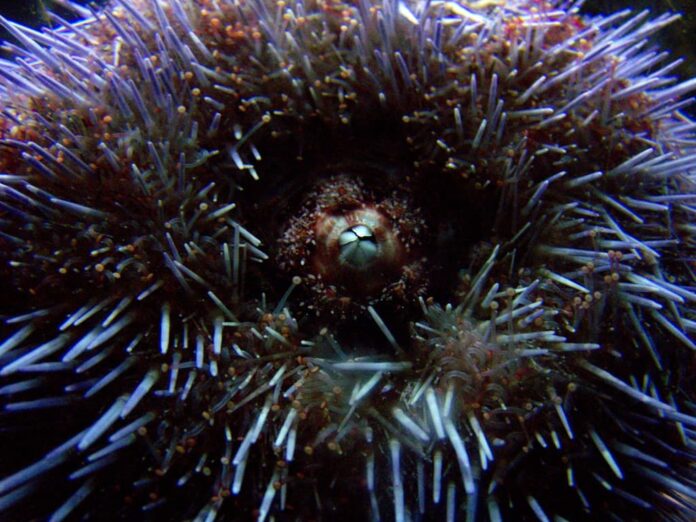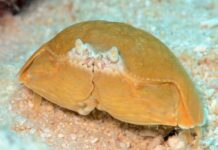Sea urchin or sea porcupine, is a spiny invertebrate that dwells on the seafloor of all oceans around the world. The word “urchin” is actually an old term for hedgehog, making it the perfect description of the creature. Many people enjoy eating them, and sea urchins can be very expensive when their quality is high. There are many more things to know about these invertebrates than just the meal, and you will find them below. We are going to discuss some details about sea urchins today, so feel free to take a look.
1Appearance

A sea urchin has a ball-shaped body with long pointy movable spines all over it. The exterior part of its body is a shell made of rigid body plates that serve as protection for its soft inner body parts. The most common colors of these spiky balls are black, brown, dark purple, green, pink, and many more. Different sea urchin species have different colors, shapes, and sizes, and they all look fascinating. An average sea urchin is between 3 centimeters to 10 centimeters in size. The biggest species can grow as large as 35 centimeters in diameter which is huge. The awesome part is that sea urchin bodies have radial symmetry, meaning they can be divided into 5 equal parts.
Along with the shell, the spines on their bodies also play an important part in protecting the sea urchins. The scattered on their spines are actually claw-like structures known as “pedicellariae”. The pedicellariae have 3 daily jobs: defend against predators, gather food, and keep the body clean. Sea urchins do not have a recognizable face, but they have an identifiable anus and mouth. Inside the mouth are 5 rigid teeth made of calcium carbonate along with another structure that works as a tongue. At the same time, they also have 5 rows of paired tube feet with suction parts that function as legs. These legs allow them to push themselves across the ocean floor and attach to rocks or similar surfaces. Depending on how much water it pumps into the tubes, the pressure can be lower or higher for movements.
2Behavior

Sea urchins are non-aggressive and slow-moving animals that don’t injure humans on purpose. Most injuries are from accidents when divers or swimmers brush or touch them, or a person accidentally steps on one. Some sea urchin species are poisonous, and they can be deadly to humans when consumed. An example of that is the flower urchin, the most dangerous sea urchin because of its venomous spines. The poison from the spines contains Contractin A (causes body spasms and clump red blood cells) and Peditoxin (causes anaphylactic shock and convulsions. A puncture wound from a poisonous sea urchin looks red and swollen, and it needs immediate treatment before causing infections. Multiple puncture wounds can cause muscle paralysis and respiratory failure, and even death.
Sea urchins mate in spring, and they practice external reproduction where the females release eggs and the males release sperm cells in the water. A female releases between 1000 to millions of eggs at a time but only a small percentage of those are fertilized. Within 24 hours, the fertilized eggs will become embryos and undergo the larval stage for several months before maturing into adults. The larval stage can take as long as 5 years before they turn into adults. In this stage, the sea urchins swim with other tiny animals as a part of the zooplankton. Even as adults, sea urchins do not have detectable eyes. However, scientists believe that their bodies allow them to see because these spiky animals are responsive and sensitive to light.
3Feeding & Habitat

These spiky marine invertebrates are omnivores so they mainly feed on both animals and plants. Their main diet consists of algae, seaweed, and plankton from nearby underwater corals and rocks. At the same time, they also eat barnacles, dead fish, mussels, and sea sponges that they can find. Thanks to their special mouth, the “Aristotle’s Lantern, they are able to scrape organisms off a surface as they move over. Plus with the teeth with their own jaws, eating is so easy and simple for the sea urchins.
There are over 950 species of sea urchins, and they live in all 5 oceans in the world. Some species prefer deep seabeds while others live in shallow waters where divers often come across them. Sea urchins usually live on ocean seabeds, especially warm waters near coral reefs or kelp beds on rocky ocean floors. Each species is advantageous to the habitats in its own different ways. For example, inky black sea urchins help to keep the Caribbean coral reefs healthy by keeping plant growth down.
4Predators & Threats

Because of their hard spiny shells, their common predators are the ones with the ability to claw through those spines. Those include crabs, eels, lobsters, sea otters, sunflower stars, triggerfish, and of course, humans. All predators eat both the sea urchins and their eggs, and they are also very expensive in big restaurants. If not being hunted, most sea urchins can live up to 30 years. Red sea urchins are probably the species with the longest lifespan, living up to 200 years or longer.
People often fish them for food because of their delicacy and high price, and only 18 species are edible. This is why some sea urchin species are also endangered. Apart from overfishing, ocean pollution is also one of the major threats to their population as well. There have been attempts to reproduce them in captivity, but they have not been successful. Sea urchins require certain conditions for breeding to take place, and only their natural habitats can provide that. The only way to protect them is by reducing catching them and keeping the oceans clean.
Related Post: Interesting Facts About Marine Iguana




